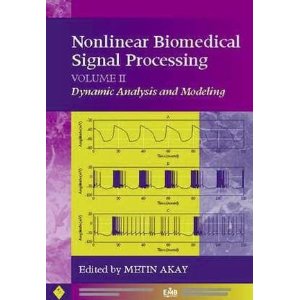Nonlinear Biomedical Signal Processing: Dynamic Analysis and Modeling, Volume 2
IEEE Press Series on Biomedical Engineering

Preface
Nonlinear Biomedical Signal Processing, Volume 11 discusses the concepts, recent advances, and implementations of nonlinear dynamical analysis methods. This volume covers the phase plane, fractional Brownian motion analysis, critical points, limit cycles, domains of attraction, bifurcations, Poincare section, linear and nonlinear sta- bility, and asymptotic analysis using multiple time-scale and averaging method. In addition, the development of an original mathematical simulation and modeling of physiological systems are presented. Finally, several biomedical examples and related MATLAB@ and Pascal programs are included.
Chapter 1 by Henry et al. offers an extensive overview of widely used nonlinear dynamical analysis techniques and the dynamical systems theory and their implementa- tions.
Chapter 2 by Yambe et al. investigates the origin of chaos in the cardiovascular system and nonlinear dynamical analysis of the baroreflex system and other clinical applications.
Chapter 3 by Fusheng et al. reviews the approximate entropy and its application to the analysis of heart rate variability signals.
Chapter 4 by Celka et al. discusses the parsimonious modeling of biomedical signals and systems and its applications to the cardiovascular system.
Chapter 5 by Maier et al. reviews the nonlinear behavior of heart rate variability as registered after heart transplantation as an alternative approach to assess and predict the restoration of the normal characteristics of heart rate variability in heart transplan- tation subjects.
Chapters 6 by Teich et al. focuses on several measures and models of the heart rate variability signals for assessing the presence and likelihood of cardiovascular disease.
Chapter 7 by Schulz et al. discusses the ventricular-arterial interaction after acute increase of the aortic input impedance using recurrence plot analysis.
Chapter 8 by Sornmo et al. presents the analysis of electrocardiography and vector cardiographic signals influenced by respiratory movements using the maximum like- lihood method for eliminating the respiratory-induced variations, to obtain accurate morphologic measurements.
Chapter 9 by Porta et al. is devoted to the detection of nonlinear dynamical analysis of sympathetic activity using several methods, including superposition plot, recurrence map and space-time separation plot.
Chapter 10 by Signorini et al. presents the use of nonlinear dynamical analysis of heart rate variability signals for the detection and prediction of cardiovascular diseases.
Download
*
IEEE Press Series on Biomedical Engineering

Preface
Nonlinear Biomedical Signal Processing, Volume 11 discusses the concepts, recent advances, and implementations of nonlinear dynamical analysis methods. This volume covers the phase plane, fractional Brownian motion analysis, critical points, limit cycles, domains of attraction, bifurcations, Poincare section, linear and nonlinear sta- bility, and asymptotic analysis using multiple time-scale and averaging method. In addition, the development of an original mathematical simulation and modeling of physiological systems are presented. Finally, several biomedical examples and related MATLAB@ and Pascal programs are included.
Chapter 1 by Henry et al. offers an extensive overview of widely used nonlinear dynamical analysis techniques and the dynamical systems theory and their implementa- tions.
Chapter 2 by Yambe et al. investigates the origin of chaos in the cardiovascular system and nonlinear dynamical analysis of the baroreflex system and other clinical applications.
Chapter 3 by Fusheng et al. reviews the approximate entropy and its application to the analysis of heart rate variability signals.
Chapter 4 by Celka et al. discusses the parsimonious modeling of biomedical signals and systems and its applications to the cardiovascular system.
Chapter 5 by Maier et al. reviews the nonlinear behavior of heart rate variability as registered after heart transplantation as an alternative approach to assess and predict the restoration of the normal characteristics of heart rate variability in heart transplan- tation subjects.
Chapters 6 by Teich et al. focuses on several measures and models of the heart rate variability signals for assessing the presence and likelihood of cardiovascular disease.
Chapter 7 by Schulz et al. discusses the ventricular-arterial interaction after acute increase of the aortic input impedance using recurrence plot analysis.
Chapter 8 by Sornmo et al. presents the analysis of electrocardiography and vector cardiographic signals influenced by respiratory movements using the maximum like- lihood method for eliminating the respiratory-induced variations, to obtain accurate morphologic measurements.
Chapter 9 by Porta et al. is devoted to the detection of nonlinear dynamical analysis of sympathetic activity using several methods, including superposition plot, recurrence map and space-time separation plot.
Chapter 10 by Signorini et al. presents the use of nonlinear dynamical analysis of heart rate variability signals for the detection and prediction of cardiovascular diseases.
Download
*